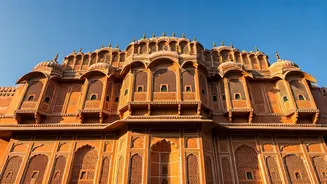Ancient Origins Revealed
The Shore Temples of Mahabalipuram, a significant UNESCO World Heritage Site, narrate stories of ancient engineering and devotion. These structures, located
on the Coromandel Coast of Tamil Nadu, were constructed in the 7th and 8th centuries by the Pallava dynasty. The temples comprise three principal sanctuaries: the Shiva temple, the Kshatriyasimhesvara temple, and a reclining Vishnu shrine, all facing the Bay of Bengal. They showcase a remarkable blend of Dravidian architectural styles, with intricate carvings and meticulously planned layouts. The location of the temples along the coast underscores the Pallavas' maritime trade and cultural exchange with other regions. The temples stand as a testament to the Pallava's skill and commitment to art and religion.
Architectural Marvels
The architecture of the Shore Temples is a remarkable example of Dravidian artistry. The primary structure, a five-story temple dedicated to Lord Shiva, is a visual spectacle, demonstrating symmetry and balance. The Kshatriyasimhesvara temple, situated beside the main temple, further enhances the complex. The meticulous carvings on the walls depict various deities, mythological figures, and scenes from daily life, giving insight into the beliefs and artistic practices of that period. These designs show the Pallava's mastery of stone masonry, with each element carefully created. The construction of the temples illustrates the sophisticated engineering techniques used during the time. The strategic positioning of the temples, exposed to the sea, also showcases the Pallavas' skill in integrating architecture with the natural environment.
Coastal Significance Examined
The location of the Shore Temples near the sea plays a crucial role in their historical and cultural significance. The Pallavas, who were skilled seafarers, built the temples to highlight their maritime trade connections and cultural exchanges with other regions. The coastal setting not only provided a practical advantage for trade but also served a spiritual purpose. The temples were designed to capture the beauty of the sea and the movement of the sun, enhancing the religious experience. Additionally, the sea has influenced the temples over time, leading to erosion and the need for maintenance. The temples were built to withstand harsh weather, highlighting the engineering skills. This coastal location makes the temples a symbol of India's maritime history.
UNESCO Recognition and Legacy
The UNESCO World Heritage status of the Shore Temples underscores their global importance. This recognition ensures that the temples are protected and conserved for future generations. It attracts tourists and scholars, increasing awareness of India's rich cultural heritage. The status brings funding for restoration and preservation efforts, maintaining the temples. The temples serve as an inspiration for architects, artists, and historians. The Shore Temples are a key part of India's heritage, as they provide a glimpse into the past and connect with the country's legacy. As a result, they remain an enduring symbol of cultural significance.











